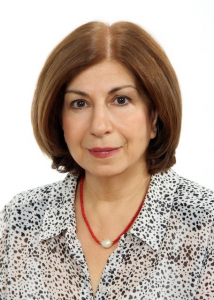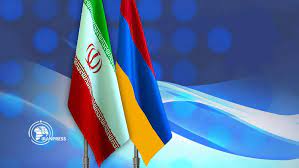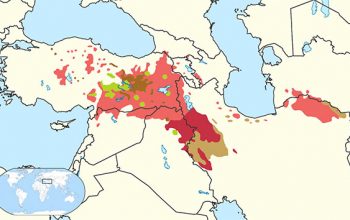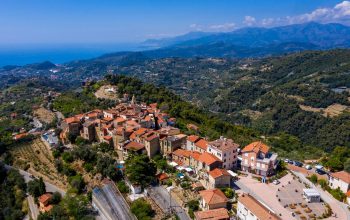
Prof. Dr. Lilit Yernjakyan
Honored Worker of Art of RA Institute of Art, National Academy of Sciences of Armenia Komitas State Conservatory of Yerevan
From ancient times to the late middle Ages music always played an important role in cultural relations between Armenia and Iran, passing through the stages of assimilation and alienation. Disparities in religion and ideology on the one hand, and certain political ties and religious affinities with Byzantine on the other, did not impede such contacts. Of course, it is impossible to fully restore the historical development of the musical cultures of Iran and Armenia in their interaction and interweaving. Entire stages of the historical path remain unknown to us due to the scarcity of factual material. They are especially evident in the advanced genres of folk-professional music, i.e. makams and dastgahs, bard music, ashugh love dastans, and instrumental-sazandar music.
The early developmental stages of the art of mughamat are linked to the musical culture of medieval Iran. Music of the Sasanian period undoubtedly played an important role in the Near East, but it is also apparent that this art developed from relations between Iran and other nations and was enriched by their accomplishments. The system of Iranian avazes and dastgahs was always perceived as classical in the Middle and Near East. However, in Armenia the art of mughamat acquired a special interpretation through influence from different branches of indigenous monody. As distinct from other eastern cultures, where makams are monumental structures for both voice and instruments, Armenian musicians as mugham players developed a purely instrumental branch of the all-eastern makamat.
There is historical evidence that two musicians, Persian Barbad and Armenian Sargis, who played an important role in the royal court of Shah Khosrow II, were invited to Ctesiphon to participate in the canonization of Iranian “royal”, the so-called “Khosrowani” modes and classic tunes[1]. Their authority was undisputable, their names were glorified by the medieval eastern poets, and they were represented in the miniature paintings created in various art schools of the Islamic East. To them both written and oral tradition ascribes legendary stories.
It can be inferred that Sargis as well as other famous musicians who were invited to Shah’s court, among them Greek Nakisa, etc., must have brought with them their own musical traditions, theoretical principles and performance art that had been purified in their own cultural centers. This is why we can ascertain that the musical system created by them and known under the name “Khosrowani style”, is a synthesis of various art traditions. Similar canonization processes can be observed in the Armenian sacred song art in 7th to 8th centuries, namely in composing one of the first collections of Armenian religious songs, improvements in sermons, that is canonization of eight mode system, octoichos of Armenian religious music and development of the first manuals of spiritual songs[2].
In medieval East, international norms, irrelevant of the ethnic boundaries of musical art, were being developed, and knowledge of theoretical roots and adherence to them was mandatory for professional musicians. The trend of canonizing musical art, in addition to sustaining the traditions of the past, facilitated the development of eastern musical genres based on normative thinking. This is evidenced by the “Khosrowani style” profoundly meaningful in Armenian Church music, the roots of which date back to Sasanian period and connect with the above mentioned processes of canonization of eastern modes that were undertaken by Khosrow Parviz and had a revolutionary significance in art. Armenian Church officially recognized this widely embracing and ancient phenomena. Catholicos Nerses Shnorhali (12th century) expanding this style in his works affirmed the sustainability of cross-penetrations of various styles in musical art.[3]
Most ancient melodies close to “Khosrow style”, with elements of melismatic phrasing and modulation or harmonic tetrachord containing modes such as “From the Virgin Stone” and “Virgin Mary” have become typical models for creation of different monodies. As for the canonized and traditional modal phrases available in the basis of the wide range of melodies such as “From the Royal Sleep” (created in 1707) by medieval poet musician Baghdasar Dpir, famous songs of the prominent Armenian ashough Sayat-Nova “From That Time on You’re Wise”, “The Gardener” of ashough Shirin are organically linked to Iranian and Armenian versions of dastgah Chahargah[4].
The study of various versions of Chahargah that are considered to be the “heart” of eastern makamat as well as of Armenian sacred and ashugh songs, reveals similarities in emotional and psychological state likewise. This allows us to speak of special semantic sustainability of Chahargah mode , uniqueness of sound system characterized by emotional weight of intervals typical to it, and mandatory-canonized and passing from tradition to tradition phrases that bear a semantic “code”.
It is noteworthy that in the musical theoretical sources of the East as well as in the work “Eastern Music” of the 18th century famous Armenian musician Tamburi Arutin, Chahargah is considered an avaze-makam embodying the Sun.[5] To continue the symbolic representation of Chahargah characteristics, I want to signify modal-intonation phrases conditioned by four fulcra present in its architectonics; in Iranian and Armenian traditions it is as a rule comprised of four parts – Maglub, Maglif, Mansuria and Bastanigar, and in Iranian Radif there is an abundance of the so-called chahar-mezrab and chahar-bagh gushes the names of which are associated with the four rivers, gardens and hierarchy of heavenly ascend in Islamic paradise.
The above mentioned parameter that relates to Islamic mysticism’s, Sufism’s cognitive system and numerical symbolism, testifies that the issue of interrelations is not limited solely to the similarities in structural and modal-intonation elements and rules for their formation. The relationship between Christian spiritual music and Islamic makam, incoherent and disjointed as it might seem at first, is anchored on more fundamental basis, the functional essence of which has subsisted during the natural developmental processes of peoples’ religious art. The function of monophonic sample’s performance is the same, which is conditioned by the equal weight in semantics.
In the depth of genetic and typological similarities, one can observe a strong syncretic core that was forged in the religious rituals and that best facilitated the canonization in repetitions and variations of certain musical-poetic passages, at the same time, leaving an opportunity for sudden flights of soul and mind.
This very link between canon and improvisation characterizes makam as a musical genre and phenomenon, the spiritual essence of which is illustrated through Sufi poets’ texts, rich in religious philosophical concepts and traditional symbols lying in the basis of dastgah’s vocal chains (Rumi, Hafez, Jami, Navoyi), as well as the so-called “rah-ruh” (path of the soul) gushes, with which the monumental Iranian dastgahs are saturated.[6] The interactions between music and rituals of religious-worship supported the crystallization of makam genre in the sphere of Sufi’s religious aesthetic perceptions and interpretations. The flow of music stimulated the flow of emotional changes, thus, on this level, making the two states analogous, that of makam, in the sense of “halt” and “ hal” in the sense of divine prophecy which form the axis of Sufi ideology. As is known, makams are 4,7,10 fundamental halts which the Sufi passes on the way of his spiritual ascend, to connect with the divine being, fuse into it and vanish.[7] From the point of music, makam is a perfect modal structure, where consistent intonation-rhythmic development of the mode by means of improvisation, gives birth to a comprehensive work achieving a top-ecstatic auj (comparable to ecstatic vajd).
In this context it is worth mentioning Sahari, the sunrise spiritual hymn played on zurna, dating back to pagan times and performed nowadays at traditional holidays and rituals. With its multi-faceted manifestations, it is substituted by N. Shnorhali’s “Morning Light” spiritual song. We come across the term Sahari still in the 16th century, in the works of the poet Grigoris Aghtamartsi “Morghi Sahar” meaning bird of the dawn. The melody is played at all kinds of ritualistic ceremonies, when birth, marriage, rite of passage, sacrifice are expected. In some regions of Armenia, Sahari is played on the next morning of a wedding to announce the innocence and purity of the bride. Until the mid-20th century the tradition was recollected by elderly zurna players on how many families they ruined by not playing Sahari. The name of this hymn, devoted to the Sun, is an Arab-Iranian terminological borrowing. Armenians, have for centuries called one of their melodies Sahari, which in modern times has found new genre manifestations (film music, symphonic music, etc.).[8]
Whereas in Armenian reality Sahari is one of those everlasting phenomena, never loosing its spiritual-sacred essence. In contemporary music of Iran, it is a popular song under the name “Morgh-e Sahar”, accompanied by string, wind and percussion instruments, based on patriotic themes[9]. Conclusively, it can be stated, that in the case of Sahari we are dealing with different manifestations, so the terminological borrowings do not necessarily imply the same genre interpretation.
Sahari is a classic example of ritual music, where the pagan spirit is revealed through numerous repetitions of similar structural-modal elements, the use of high registers of sound range of the instrument, which eventually creates a static meditative state. Melodies characterized by the above mentioned properties, occur in musical-poetic episodes of Armenian ashugh love stories, especially in the appeal songs to the Lord and Saints.[10]
The love stories of Shasenem and Gharib, Leyli and Mejnun, Khosrow and Shirin, Asli and Kyaram, have found different interpretations in Iranian, Armenian, and Turkish language speaking peoples’ works, the mere titles of which model the genre.
It is noteworthy that plot compositions, especially the genre of novel were widespread in medieval Armenian literature. We know Hovhannes Yerznkatsi’s (XIII) poem on the love story of Christian priest’s son and the mullah’s daughter (Hovhannes and Aysha), the verses of Arakel Baghishetsi (XIV-XV), Grigoris Aghtamartsi (XV-XVI) and others, on the eternal topic of the “Nightingale and the Rose”, with their concise structure and basis, relate closely to the thematic core of eastern love story.[11] The parallels do not however, predetermine a one-sided influence; the musical-poetic and narrative tradition is impossible to borrow or replicate automatically, if the deep cultural basis is lacking. Armenian poetry as well as professional song art of the late middle ages are abandoned in bilingual, tri- and quadrilingual poems which were the consequence of interactive relations between different ethnic groups.
Suffice it to mention Armenian prominent ashugh Sayat-Nova who has become an aesthetic standard in Armenian culture and has become the symbol of perfection of ashugh song art and national identity. His role in the development and sustainment of musical-poetic relationships of the Caucasian and Iranian peoples in the late-medieval period was great. Being a court musician of Georgian king Irakli II, Sayat-Nova was the first who voiced Iranian melodies in Georgian, making it popular in Tiflis, a multi-national cultural center of Trans-Caucasus in his own way. Composing in four languages (Armenian, Georgian, Persian and Azeri) and personifying the ideals of neighboring nations in musical poetical characters, Sayat-Nova, first of all, was the successor of gusan art of ancient Armenia and medieval poet melods. He made a pilgrimage trip to St.Karapet’s monastery, the protector of Armenian ashughs, and was initiated to minstrelsy according to national ashugh tradition.[12]
Bearers of the sacred knowledge and love, the ashughs, are plaited into the given social-cultural environment. The testimony of the above said, is the behavior and songs of all the characters madly in love, Mejnun, Kyaram and Gharib as well as the name “Ashik Kerib’s” beloved, Mahul-Mehri (Sun and Moon), recorded by M. Lermontov.[13] The meaning of the word Gharib (foreigner, immigrant), itself has a special connotation in Armenian reality. No surprise that the motive of roving has greatly contributed to perceptions of national origin of the romance and its popularization.
The pervasive existence of ashough love romance in Near and Middle East is widely conditioned by several religious-ritualistic function bearing constituents available in the genre’s structure, the assimilation of which by Islamic and Christian cultures does not exclude similarities in their archaic forms.
Komitas archimandrite, the founder of the Armenian national composer’s school, who was among the pioneers of ethnomusicology (Karl Stampf, Eric von Hornbostel, Robert Lachman) in one of his articles on Armenian music stated, that “The mutual influence of national styles is an undeniable phenomenon, and there is no nation that remains isolated from such merging of idioms. Only that of animals, which vocalize the same sound and the same intonation, for they do not have the gift of borrowing”. He himself studying different eastern nations, namely Persians, Turks, Kurds musical folklore, acknowledged the importance of cultural interrelations.
On the example of cultural realities in Armenian and Iranian traditional art music, I tried to touch upon those sacred values which penetrated into the works of the musicians of the East, brought together Christian and Muslim musical worlds, at different times.
Of particular interest is the issue of the links of mughams with the work of professional composers of Armenia. Already at the first stage of the development of the national school of Armenian professional music (the end of the 19th century), interest in the Eastern traditional genres of monody is shown.
Nikoghayos Tigranian was the first composer who recorded and arranged samples of Eastern classical instrumental music – mughams and dastgahs. Committing himself to the study and development of Eastern classical music, Tigranian had the opportunity to listen to it in the form this music had been used in everyday life of Armenians for centuries, where it, subjected to changes, became the property of not the East, in general, or of Iran, specifically, but especially that of Armenian urban musical culture. It appears that due to this very reason, in spite of the fact that he published his arrangements of ten pieces under the title “Iranian mughams”, they have standard traits typical of the Armenian art.
An inexhaustible source of inspiration for Tigranian was a virtuoso tar player from Yerevan Aghamal Melik-Aghamalyan, who, in recognition of his art, was presented with a tar (Eastern string musical instrument) from the royal collection of Iran’s Shah. Aghamal closely cooperated with the Persian singer Sattar. Being a brilliant performer of classical pieces, Aghamal Melik-Aghamalian was at the same time developing the instrumental branch of mughamat art typical of Armenia.
In the works of subsequent generations of Armenian composers, directly or indirectly in touch with the art of mughamat, the synthesis of two Easts appears in the complex interaction of the traditional Eastern and European professional arts. The effect of this type of interaction could be traced in the works of such classics of Armenian national music as Alexander Spendiaryan (opera “Almast”, “Yerevan etudes”), Grigor Yeghiazaryan (symphonic poem “Towards the Sunrise”).
On the other hand, Armenian professional musicians made varied contributions to Iranian music with particular focus on Iranian classical music, including its modal traditions, to the art of making Iranian instruments etc. Social musical and enlightening activities of Iranian-Armenians is valued within the context of professional music of Iran in general.
The Armenian professional musicians initiated different projects in different fields, including the staging of the first operatic works, formation of the first symphonic orchestras and multi-voiced choirs, the foundation of а string quartet, translation of the first study books, development of innovative theories contributing to the violin and piano performing traditions. They were also actively involved in the process of the foundation of the conservatory as well as music schools in several towns of Iran. They also authored the first multi-voiced and orchestral arrangements of the national anthem of Iran.
In terms of cultural relations, in the “basin” of the Near East, Armenian traditional art music developed both on its national foundation, within the organic boundaries of folk, spiritual and old gusan music and in the all-eastern context, being its active participant.
Research in the field of canonized traditional genres in Islamic and Christian traditions, and the cultural realities lying in their roots, opens new perspectives in the study of archetype elements, spiritual substrates present in the traditions of Eastern music. In some sense, it also clarifies the wide spread existence of genres, plots and motives, typical for the Near East.
[1] Christensen A., L’ Iran sous les Sassanides, Copenhague, 1944, p. 485
[2] See Tahmizyan N., Barsegh Tchon and the Flourishing Song – Art in Armenia in VII Century, “Banber” Yerevan State University, 1973, N1
[3] Ghevond Alishan writes that Armenians developed the “Khosrow style’ in their works and sites the words of Kirakos Gandzaketsi on Shnorhali that the latter “regulated sharakans, songs, melodies and poems written in Khosrow style”, see Alishan Gh., “Shnorhali and his work” Venice, 1873, p.98; also Tahmizyan N., Nerses Shnorhali: Musician and Composer, Yerevan, 1973, p.23
[4] Yernjakyan L., “From the History of Armenian-Iranian Musical Links”, Yerevan, 1991, p. 81–95.
[5] Tamburi Arutin, Treatise on Eastern Music, Translated from Turkish, Preface and Comments by N.Tahmizyan, 1968, p. 54
[6] Les Systemes de la Musique Traditionnelle de l’Iran, Teheran, 1973 (par M. Barkeshli); Radif Vocale de la Musique Traditionnelle de l’Iran, Teheran, 1978 (par M. Massoudieh)
[7] Islamic Spirituality: Manifestations, ed. by Seyyed Hossein Nasr, Crossroad. New York, 1991
[8] Yernjakyan L., Pikichyan H., Hymn to the Sun, “ Sahari” in Armenian Music, Yerevan, 1998
[9] The legendary Iranian singer, connoisseur of Iranian classical music Mohammad-Reza Shajarian sang this song “as anchor” in a one of his tours in the United States in 1990. See Mohsen Mohammad, The bird of Dawn: An Iranian Jewish Musicians in L.A., 2010.
[10] See Yernjakyan L., Ashough Love Romance in the Context of Near eastern Musical Interrelations, Yerevan, 2009, p. 83–89
[11] See Armenian Classical Lyrics, vol. 2, Middle Ages (XII-XVII), Yerevan, 1988
[12] Yernjakyan L., Music-Aesthetical Foundations of Sayat-Nova’s Songs, in: Sayat-Nova – 300, Yerevan, 2012, p. 7–22
[13] In 1837, Lermontov recorded the tale of “Ashik Kerib” which later was translated into Armenian (1857) by Stepanos Nazaryan, cabardin (1864) and Georgian (1865). The homonymic dastan was published in Azerbajani in 1892. G. Hakhverdyan, the first researcher of famous ashugh Sayat-Nova’s life and work, recorded the content of Ashugh Gharib from variants alive in Tiflis (1852). Parralel to M. Lermontov, Kh. Abovyan recorded and included in German language written article “Armenian Spiritual and Folk Music” the romantic love stories of “Ashugh Gharib” and “Asli Kyaram”. See Kh. Abovyan, Collection of Works , vol.10, 1961, pp. 59–110


